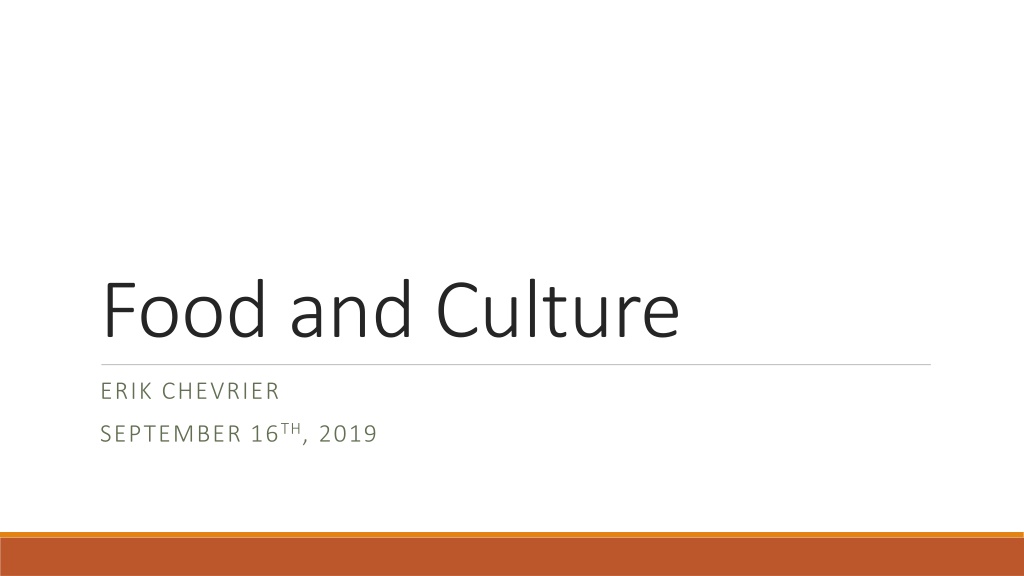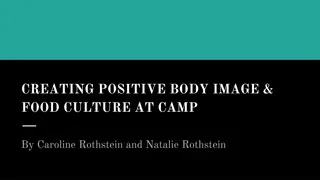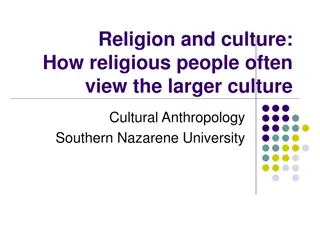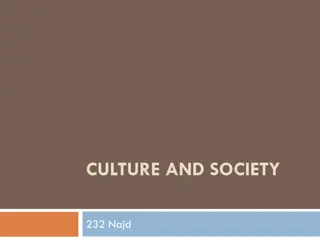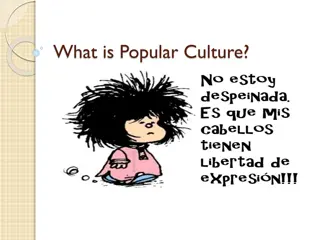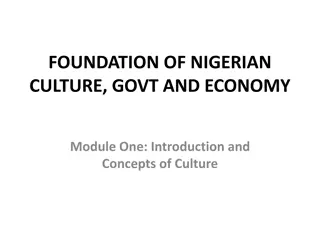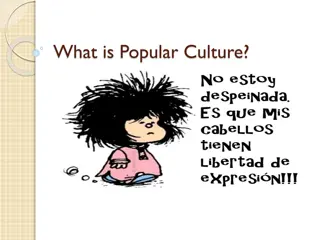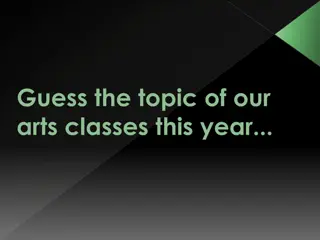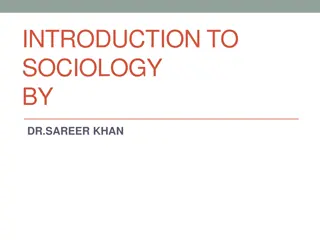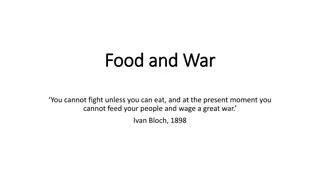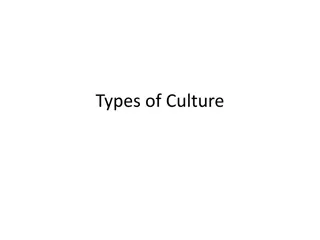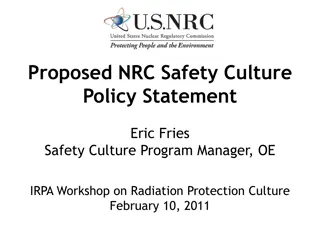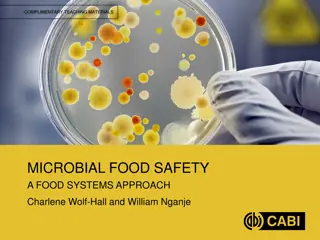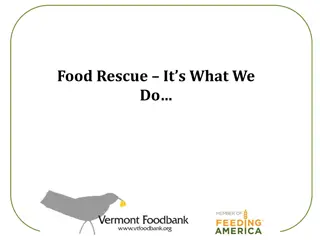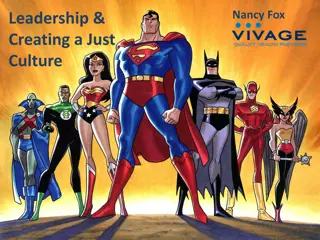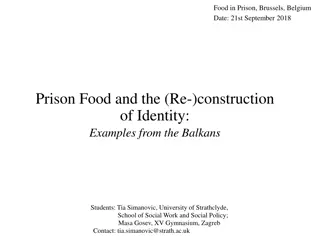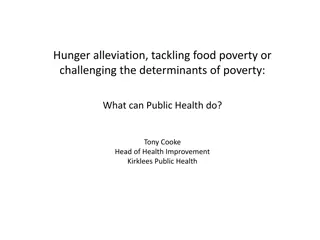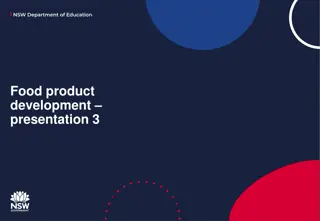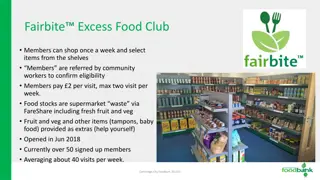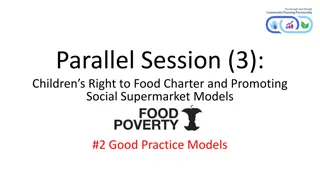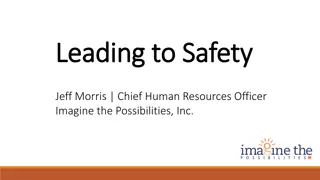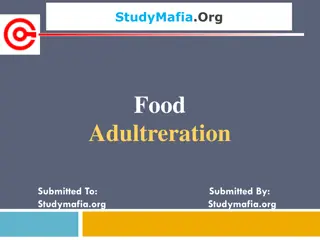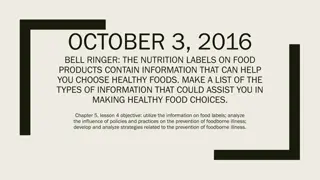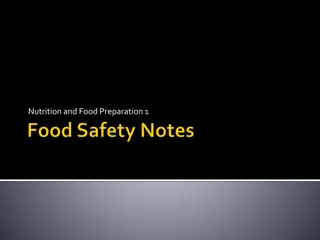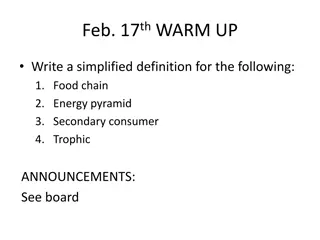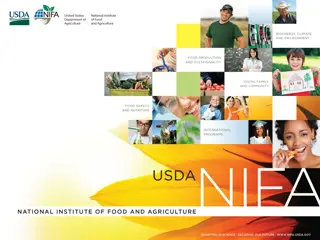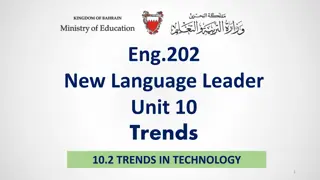Exploring the Relationship Between Food and Culture
Food culture encompasses practices, attitudes, and beliefs surrounding food production, distribution, and consumption, reflecting a group's identity, values, and creativity. Cultural norms influence how individuals interpret food, highlighting the dynamic interaction between food and society in shaping meaning and behavior.
Download Presentation

Please find below an Image/Link to download the presentation.
The content on the website is provided AS IS for your information and personal use only. It may not be sold, licensed, or shared on other websites without obtaining consent from the author. Download presentation by click this link. If you encounter any issues during the download, it is possible that the publisher has removed the file from their server.
E N D
Presentation Transcript
Food and Culture ERIK CHEVRIER SEPTEMBER 16TH, 2019
Discussion What is food? What is culture? What is the link between food and culture?
What is Culture? Raymond Williams A general process of intellectual, spiritual and aesthetic development. A particular way of life, whether of a people, period or group. The works and practices of intellectual and especially artistic activity. Nesbitt-Larking The general process of intellectual, spiritual, and artistic development of a people. The entire way of life of a people, in terms of those practices and facts through which they express their meaning. High culture the works and practices of intellectual artistic activity Culture is the way of life of a people, in particular their evolving ideas, beliefs, and values as they are understood, communicated and represented. Bennett Culture consists of all those practices (or activities) that signify; that is, which produce and communicate meaning by the manipulation of signs in socially shared and conventionalized ways.
What is Food Culture? Food culture refers to the practices, attitudes, and beliefs as well as the networks and institutions surrounding the production, distribution, and consumption of food. It encompasses the concepts of foodways, cuisine, and food system and includes the fundamental understandings a group has about food, historical and current conditions shaping that group s relationship to food, and the ways in which the group uses food to express identity, community, values, status, power, artistry and creativity. It also includes a groups definitions of what items can be food, what is tasty, healthy, and socially appropriate for specific subgroups or individuals and when, how, why, and with whom those items can or should be consumed. Source Dr. Long
You Are What You Eat Spillman Human process of meaning-making generating artifacts, categories, norms, values, practices, rituals, symbols, worldviews, ideas, ideologies, and discourses. - institutions - specific or defined group - part of everyday interactions How social interactions convey meaning and how meaning is interpreted.
You Are What You Eat Anne Swidler Culture is toolkit or repertories A realistic cultural theory should lead us to understand that people are not passive cultural dopes but rather active, sometimes skilled users of culture whom we actually observe Culture should be viewed as a collection of culturally defined elements From a reparatory, individuals can pick elements that sustain habitual behaviors or select tools to explore new ways of acting in the world People have agency but are also led by cultural norms
You Are What You Eat Giddens Practical consciousness Tacit understandings and intuitive decisions people make as they go about daily routines but they can t always directly express. Discursive consciousness Formal articulations and rationalizations for actions. Bourdieu Habitus Tastes become internalized and converted into a disposition that generates meaningful practices and meaning-giving perceptions Habitus typically translates people s social class into their embodied taste preferences that may give them advantages later on in life.
You Are What You Eat Cognition is a dual process Deliberate conscious process that is slow and reflexive & automatic process that is fast and intuitive. Schemas Represent deep, largely unconscious networks of neural associations that facilitate perception, interpretation and action Schemas emerge from experience and allow people from becoming cognitively overburdened in daily life. (Vaisey) Ethical foodscape A realm where good food is not simply viewed as an individual indulgence, but connects to collective obligations like sustainability, animal welfare, and social justice. (Goodman) Alternative hedonism Consuming differently (ethically) can be a source of pleasure. (Soper)
Cognitive Model & Schemas SEMANTIC PROCESSING SPREADING ACTIVATION COGNITIVE MODEL
Ecological Systems Theory of Development
Food and Culture Meaning Behind Food You Are What You Eat Whole Foods Market Karma Co-op IGA Tim Horton's I am Canadian I am not Canadian
Your Own Food Shopping Habits What do eat in a typical day? Where do you acquire food in your daily routine? i.e. home, restaurant, etc. How much of your daily food to you cook (including leftovers) in a typical day? Where do you typically shop for groceries? Why? How often do you shop for groceries? Do you grow your own food? If so, what do you grow? Think about the last time you were shopping for food at a grocery store What did you purchase? Why? Do you typically make a list before grocery shopping? If so, do you follow it? What can you remember about your subjective experience at the grocery store? What guides your food purchase decisions most? Automatic less calculated more impulsive choices? Or Well thought out, planned choices?
General Framework Richard Johnson What is Cultural Studies Anyways, Social Text, (1986-87)
Critical Multidimensional Model Paul Nesbitt-Larking. Politics, Society and the Media (2ndEdition). Broadview Press. 2009.
Analyze a brand of Breakfast Cereals Through One of These Models
Please Think About and Answer the Following Questions How does culture influence eating practices? More concretely, what kinds of food culture promotes healthy, environmentally friendly choices? What kinds of food culture undermine these choices? When (and how frequently) do food choices involve practical consciousness (i.e. habitus, emotional eating)? When (and how frequently) do people draw on a deliberative level of consciousness to make food choices, and why? What factors motivate consumers to consume sustainable foods produced with fair labour practices (e.g. fair-trade chocolate)? Do you agree with Kate Soper that pleasurable rewards are necessary to sustain alternative food practices?
Cooking for Next Week Did everyone fill out the Google Pages Link? Did you indicate which days you would bring food? Did you indicate your dietary conditions/allergies?
Le Frigo Vert Before next class, please check out! Le Frigo Vert
